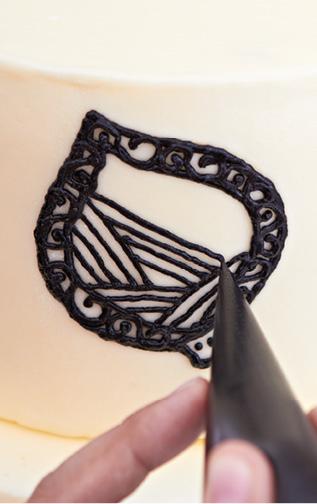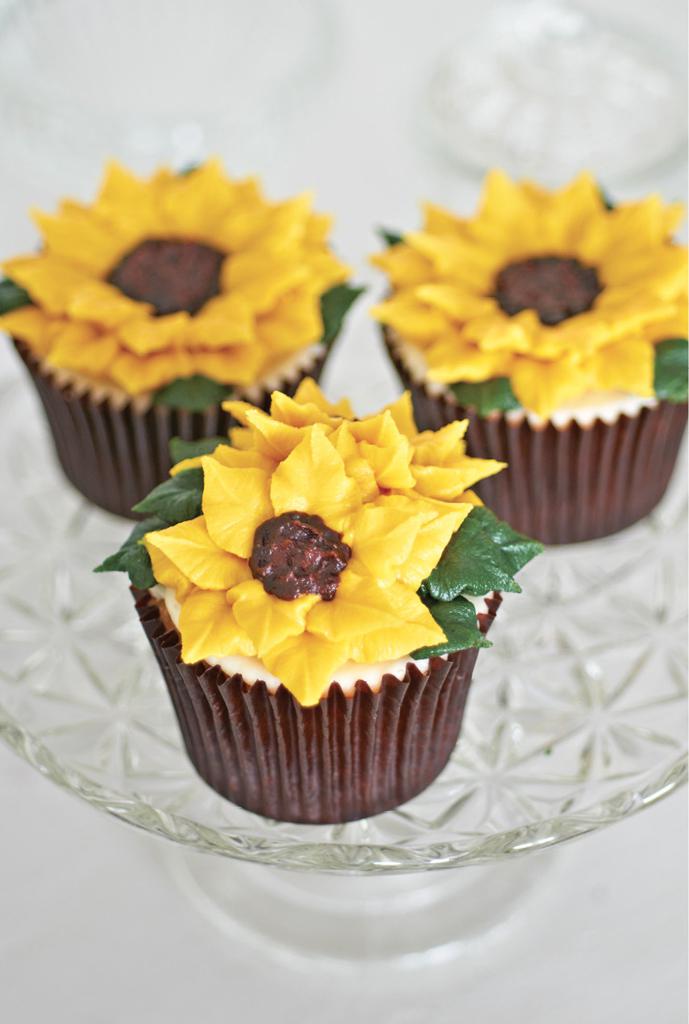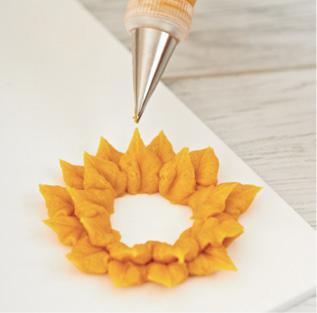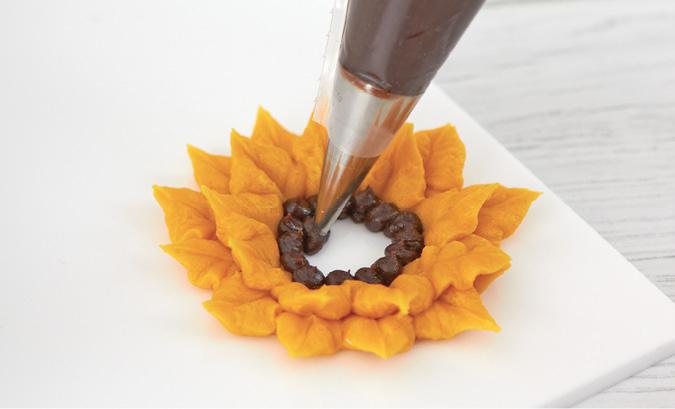The Contemporary Buttercream Bible (16 page)
Read The Contemporary Buttercream Bible Online
Authors: Christina Ong Valeri Valeriano

pattern, pipe some freehand repetitive bigger
scrolls to complement the structured patterns of the
main flower.
178


C
D
179
Tip
To practise squeezing your piping bag with
constant pressure, we suggest that you pipe
scribbles on a plate, glass or any board.
Fantastic sources of inspirations for piped
patterns include tribal art, ‘Zentangle’, and
Aztec patterns to name a few.
180

To create this cake…
• 15 × 15cm (6 × 6in) round cake (top tier), 20 ×
7.5cm (8 × 3in) round cake (bottom tier)
• Dowel rods
181
• 1.45–1.85kg (3lb 31⁄2oz–4lb 2oz) buttercream
• Paste colours: green (Sugarflair Gooseberry), grey
(Sugarflair Liquorice), black (Sugarflair Liquorice)
• Piping bags
• Cookie cutters
• Ruler
• Greaseproof (wax) paper
• Cocktail stick (toothpick)
• Scissors
• Cake stand or covered board
Colour 600–700g (1lb 5oz–1lb 9oz) of buttercream
green, 400–500g (14oz–1lb 2oz) grey, 250–350g
(9–12oz) black and leave the rest uncoloured. Cover
the top tier with green buttercream and the bottom
with grey, reserving some of the green and grey to
pipe the lines on the lower tier, then give both cakes a smooth finish (see Covering Cakes in Buttercream
Basics). Dowel and stack them (see Dowelling in
Buttercream Basics) and place on a stand or
covered cake board. Measure the circumference of
the bottom tier cake and calculate the size you need
for equal triangles. Mark them on the cake and pipe
182
lines following the tutorial, starting with black and using the other colours alternately until the cake is covered. On the top tier, pipe the floral designs in
the same way, adding repetitive lines to fill. Pipe
some freehand scrolls between the shapes. Finish
by piping dots (see Dots in Piping Textures and
Patterns) around the upper and lower border of the
top tier.
183

Piping Flowers
There is almost nothing more popular than a floral
theme on a cake. Despite their apparent intricacy,
flowers of all sorts can be piped in buttercream,
which lends itself very well to creating delicate
petals and foliage. In this chapter we will show you
how to pipe a rich variety of flowers, from the
essential rose, to flamboyant chrysanthemums and
a posy of cottage garden favourites.
184
Sunflower and Leaves
With their vibrant and cheery yellow petals,
sunflowers can brighten your day, whether they are
planted in your garden or piped on a cake. This is a
very easy flower to create and works equally well as
a decoration for the top of a cupcake or as a feature on a larger cake. A few green leaves will really set
off the bright petals, and the following Leaves
tutorial can be used to add foliage to any floral
design.
185

Sunflowers are the first flowers that we ever learned to pipe in buttercream and remain one of our
favourites for their simplicity and striking style.
186

They look so effective when piped singly or in pairs
on cupcakes. To achieve the raised effect in the
centre of the double-bloom cupcakes, pipe a blob of
uncoloured buttercream in the centre of the
cupcake first, then pipe two sunflowers on opposite
sides. Sunflowers can also be combined on a cake to
create a masterpiece worthy of Van Gogh himself!
See the cupcake bouquet tutorial later in this
chapter to see just how effective these flowers can
look
en masse
.
Sunflower
1 Using a piping bag with a writing nozzle, pipe a
circle as a guide to the size of your flower (A).
187

A
2 Using a small leaf nozzle (Wilton 352), position
the nozzle at a 20 to 30 degree angle and have one
of the points touching your guide circle. Squeeze
your piping bag until it creates a wide base then
gently pull away, slowly decreasing the pressure on
the bag as you do so (B).
B
3 When you reach the desired length of the petal,
stop squeezing your bag then pull abruptly. Repeat
this process to pipe petals all the way around the
circle (C).
188

C
4 Pipe another layer of petals at a slightly steeper
angle than the first (30 to 40 degrees), making sure
that they are close to the first layer of petals to
avoid gaps. Ideally, you should pipe these petals
between those of the first layer (D). Finally, using
brown tinted buttercream, pipe little dots in the
centre of the flower (E).
189


